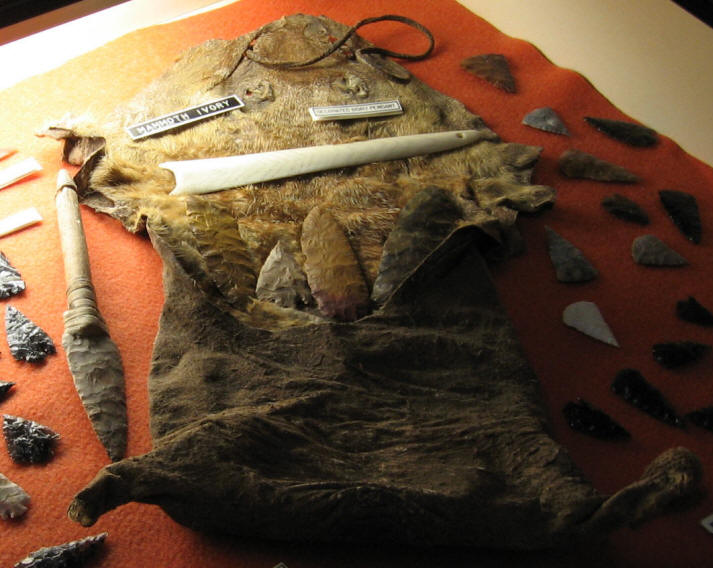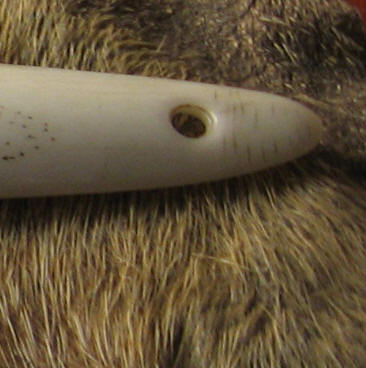



An Ancient Indian Mathematical Artifact?
|
|
|
The Story of the Nicolarsen Cache In 1960 Jack Nicolarsen and a companion were searching for artifacts at the southern end of Lake Winnemucca in Nevada when they discovered a vertical cave shaft. They went on to dig through some sixteen feet of deposits, uncovering human burials and artifacts stretching back over thousands of years. Nicolarsen made a rough diagram indicating the level at which these objects had been found. Their most important discovery was made near the bottom of the shaft. It was perhaps the oldest atlatl, or dart-thrower, found in North America, and it was radiocarbon dated to 5680 years ago. Nicolarsen lent the collection to the Department of Anthropology at the University of California in Berkeley in 1972 where Thomas R. Hester wrote a preliminary report “Archaeological Materials from Site NV-WA-197, Western Nevada: Atlatl and Animal Skin Pouches” which appeared in 1974 in Four Papers on Great Basin Anthropology, (Contributions of the University of California Archaeological Research Facility, Number 21, June, 1974.) Several months later Nicolarsen sold the collection to the Favell Museum in Klamath Falls, Oregon where it is still displayed. Two Pouches Ten feet from the surface the diggers had uncovered two pouches which appear to have been made from the skins of yellow belly marmots with the fur side forming the inside of the pouches, and the head and forelegs forming part of the flap that closed the pouches. In pouch I there were: six two-sided stone knives with tapered stick handles, two unhafted blades, two additional wooden handles, and a string 60 cm. long with feathers attached to part of it. One of the knives had a trout fish scale adhering to it, making it likely the knives were used to cut and clean fish, among other purposes. The unhafted blades showed traces of some reddish substance, and the taper on the handles suggested the possibility that the knives could be inserted into longer poles to create spears. In pouch II there were: three double-edged knife blades, one knife with a handle, a piece of deer antler bound to wood, which appeared to be a tool for flaking stone, 101 projectile points, and a bone object which is what particularly interests us. Hester described the bone object like this: “A long, trianguloid section of mammal long bone (elk?), concavo-convex in cross section, has been smoothed and polished and decorated with drilled pits. On the convex side, there are 18 double rows of these tiny depressions, forming chevron-like designs. On the reverse (concave) side, there are eight such rows of punctations. Some very faint lines are also present on the convex surface, but these may be related to grinding and abrading of the surface during the manufacturing process. The artifact appears stained, and has a yellowish color. The maximum length of the specimen is 20.2 cm., maximum width is 32mm., maximum thickness, 6 mm., (minimum thickness, 2 mm.) and the weight is 25 grams." “The function of this artifact is undetermined. It is quite similar to bone objects termed “sweat scrapers” reported from the central California (cf. Ragir 1972:Pl. 5, a; Gifford 1940:173-174, describes the use of spatula bone strigils by California Indians of the Monterey area)." (p. 10) Hester surmises that the bone implement was part of the stone knapper’s kit, if only to wipe away his sweat. The style of the projectile points allowed him to roughly date the pouches to somewhere between 600 to 1100 A.D. Robin Benson Barnes, in a dissertation written in 2000, at the University of Texas, Austin, under the direction of Hester, called Prehistoric Caches in an Intermittal Wetlands Environment: An Analysis of the Nicolarsen Cave Collection, Washoe County, Nevada, reviewed the materials. When writing about the bone object she closely follows Hester’s description of 18 double rows of tiny depressions, and so forth, but adds: “minor blunting and smoothing of protrusions on the lateral edges; intermittent step-fractures; basal edge is slightly dull; scattered reddish residues on one face near the base.” (p. 100)But she reports a radiocarbon dating of the pouch of 1330 years ago. (p.44) Mathematical Indications In a recent examination of this bone object 19 chevrons were counted on the convex face, which would be a very minor discrepancy from these previous reports except for the fact that on the tip of the convex side there were a number of small marks. There were 19 of these marks, which is unlikely to be coincidental. The irregular placement of these small marks makes it appear as if they were added at different times, and a cross mark on one of these groupings reminds of us modern tally marks, but instead of the diagonal crossing 4 uprights, here the diagonal crosses 3 uprights. It seems likely that the small marks were made on the occasion of, or soon after, the event which is being marked, while the chevrons were added later since their creation would be more deliberate and time-consuming. If we were to imagine a scenario that would embrace these possibilities, it would go like this: the hunter had as part of his tool kit this bone object, whether it was a sweat scraper or not. He notes on it in the from of the shorthand of these small marks major events, perhaps the killing of a large animal like the elk from whose bone it appears the object was fashioned. Later, perhaps in a kind of ceremonial summing up and hope for the future, he engraves the chevrons on the bone, and coats it with red ochre.
Thanks to Favell Museum for permission to photograph this fascinating item. See their website at www.favellmuseum.org
|